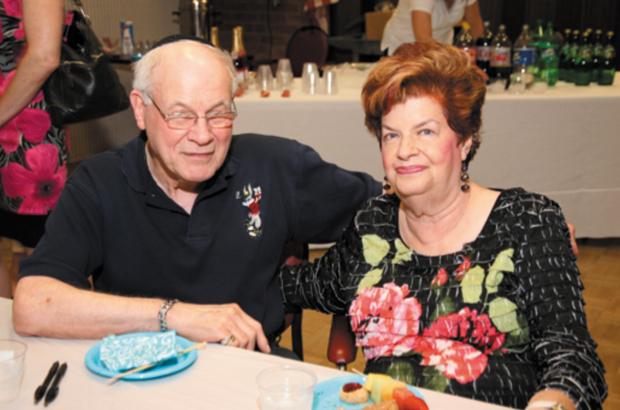News & Schmooze: Oldie but goodie
Published September 25, 2013
As Carl and Gloria Sussman explain it, when you get to be their ages you cut to the chase.
“We looked at the pros and cons and decided we ought to get married,” says Carl, 82, matter-of-factly.
“At this stage of the game, why wait?” chimes in Gloria, who is 70. She looks over at Carl from her perch on the couch, smiles, and adds, “He found himself a much younger woman.”
The two laugh as they talk and realize that yesterday marked their one-month wedding anniversary. On Aug. 19, Rabbi James Goodman of Neve Shalom Congregation married the couple in his study with 15 to 20 friends and Gloria’s daughter in attendance. Then the celebration moved from the downstairs congregation at Covenant House to upstairs, where the couple shares an apartment.
“The whole ceremony was very dear,” said Goodman, adding that it’s rare for him to marry a couple of their ages, it just doesn’t happen that often. “It was a tender thing, with their friends around them. We threw up a chuppah and did it up nice.”
That she is now Mrs. Sussman delights Gloria, who says she never expected to find love after being divorced most of her adult life. “I dated a few different men over the years but I didn’t think I would ever get married again,” she says explaining she was once married for seven years.
Carl, who is retired from the Missouri Division of Mental Health, was married for 56 years to Shirley and the couple had four children. Shirley passed away after a long-time battle with kidney disease in September 2011. Carl had been by her side during the years she was ill.
Not long after her death, he found himself with an extra ticket to High Holiday services at Nusach Hari B’nai Zion. On a lark he asked Gloria if she would accompany him. The two had been acquaintances – she once dated another member of NHBZ whom Carl knew. Gloria also lived at Covenant House, though in a different building from Carl; the two would sometimes see each other at mealtime.
“We went to services together and that was pretty much it,” said Gloria. “From then on, we started doing more things together.”
The relationship turned serious in 2012, as they began spending even more time taking walks, going to parks, eating out (Pasta House Co. is their favorite), visiting with friends and traveling.
So how, exactly, did he propose?
“Like a sledgehammer,” Carl says (though I’m not exactly sure what he means).
Gloria insists it was Carl who pursued her. For what it’s worth, Carl doesn’t argue. He tells how some men at Covenant give Gloria the once over when the two walk to the communal dining room.
“She has this certain blouse,” says Carl. “I had to tell one of the guys around here to get lost because he couldn’t keep his eyes off of her.”
I see this as an opening to gingerly inquire about intimacy. After all, my job is to ask the hard questions.
Again, they laugh, as Gloria notes if you don’t use it, you lose it. Now I’m the one blushing.
“I’m too much for him to handle,” jokes Gloria.
Carl chuckles and nods his head. “Did I mention she’s a good cook?
Joan Denison, executive director of Covenant House/Chai Apartments, says that in the history of Covenant House, it’s very rare for couples to marry.
“We are delighted that people build close relationships here that are very meaningful to them,” says Denison. “When a person has experienced the loss of a spouse, to see them find a new partner and experience such happiness at this time of their lives, well, it’s wonderful. It adds to the quality of their lives as they continue to grow old together.”
Then again, Gloria maintains that she is still very independent and enjoys her “time with the girls,” to which Carl counters, “I know to give her space.”
Westward compassion
During the recent Colorado flooding, Har HaShem, Boulder’s Reform Congregation, sustained extreme damage to its lower level, including the loss of seven classrooms. When books critical to the religious school curriculum were destroyed, Katherine Schwartz, the shul’s Education Director, reached out to major Jewish book publishers as well as colleagues in NATE (National Association of Temple Educators) asking for the books to be replaced. United Hebrew Congregation in St. Louis was able to donate almost half of the needed texts.
“I knew we had some of the books she needed that were no longer in print,” says Rabbi Roxanne J.S. Shapiro of UH, citing “The Atlas of Great Jewish Communities” and “Sefer Ha’Aggadah, Volume 2.”
Shapiro said the Boulder congregation needed 49 of the former and UH was able to send 23, and 40 of the later, to which UH had 14.
“They are great books but we haven’t used them in years,” Shapiro says. “Even if at some point they were to become a regular part of our curriculum, better (Har HaShem) uses them now then they sit on our shelves for a rainy day.”
Shapiro says UH congregants were thrilled to be able to help.
“This doesn’t happen that often,” says Shapiro. “During Hurricane Sandy, I didn’t see a call out. Maybe in more populated areas there are more congregations nearby to help. But in a place like Boulder, the community and network are much smaller.”
Shapiro said she received an email Monday from Schwartz thanking UH for the books. “She said they are muddling through,” says Shapiro. “One teacher can no longer teach because she lost her home. They are trying to deal with putting things back together, along with the rest of the Boulder community.”
















